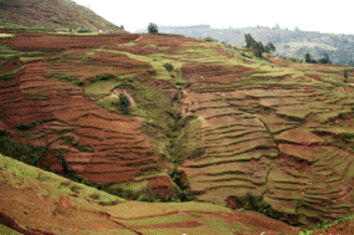Soil erosion damages
Severe soil erosion damages on agricultural land in the Gina River catchment
Image Credit: Hahl, R. 2003
On Mountain tops the least number of soil erosion damages were detected. This, despite the fact, that these region receive a relatively high amount of rainfall. The low occurrence of damages can be elucidated by the relatively dense vegetation cover. Meadow vegetation protects the soil from the splash effect. Soil particles cannot be detached. Dense root system of the grasses penetrating the upper soil horizon prevents the soil from erosion.
Soil erosion damages in the Gina River catchment only occur in areas affected by human impact. Especially paths are highly damaged by soil erosion processes. Erosion forces can effectively affect these areas covered by rare vegetation and with compacted underground.
The high intensity of sheet erosion in the Steeper slope areas can be attributed to the morphology and land use. A high inclination promotes erosion processes. Land use is determined by agriculture, mostly cereal/fallow. The lack of permanent vegetation cover impedes that water can infiltrate into the soil entirely. The higher the sum and the intensity of precipitation the higher the generation of surface runoff.
The frequently occurring mass movements in the Steeper slopes areas can be explained by soil characteristics, land use and again by morphology. Above the impermeable loamy clayey saprolite water banks up and cohesive forces between the soil particles weaken. This result to a downward movement of the water saturated upper soil layer (solifluction; Gerrard 1990, citied in Beck et al. 2004). This effect is enhanced by the low depth of the roots of cultivated crops. If cattle ascending slowly on this water saturated soils a contour parallel stepping of the slope is caused – a special type of solifluction (Auerswald 1998).
Additionally, the predominant soil texture clay loam enhance erosion processes in the Gina River catchment as it is fine textured favouring the soil removal by water (Auerswald 1998, citied in Beck et al. 2004).
Another important explanation of the occurrence of soil erosion damages is unadapted agriculture - i.e. that agricultural activities are often not adapted to the environmental conditions resprectively.
Periods of uncovered fallow and cultivation even on steep slopes are the main reasons for the damages. This applies especially for the Undulating areas where population density is the highest as well (Beck et al. 2004).
Follow the discussion of the rainfall-runoff modelling by following this hyperlink.



